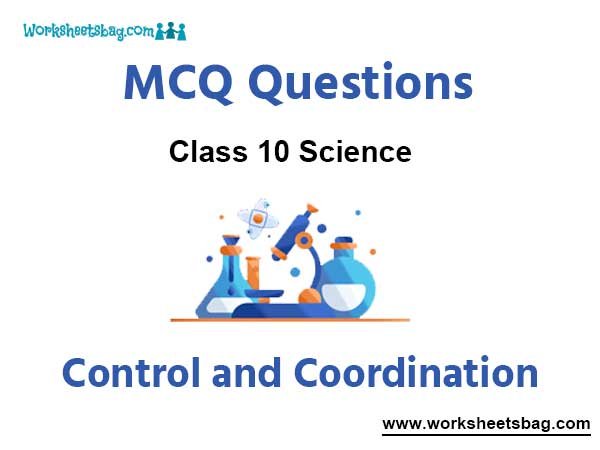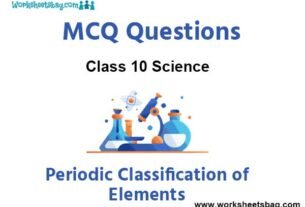Please refer to Control and Coordination MCQ Questions Class 10 Science below. These MCQ questions for Class 10 Science with answers have been designed as per the latest NCERT, CBSE books, and syllabus issued for the current academic year. These objective questions for Control and Coordination will help you to prepare for the exams and get more marks.
Control and Coordination MCQ Questions Class 10 Science
Please see solved MCQ Questions for Control and Coordination in Class 10 Science. All questions and answers have been prepared by expert faculty of standard 10 based on the latest examination guidelines.
MCQ Questions Class 10 Science Control and Coordination
Question. Which is not true about brain:
(a) there are lobes in fore brain
(b) Centres of hearing, smell, memory are located in fore brain
(c) Involuntary actions are controlled by medulla in hind brain
(d) Cerebellum does not control postures
Answer
D
Question. The plant hormone which triggers the fall of mature leaves and fruits from the plant body is:
(a) Auxin
(b) Gibberellin
(c) Abscisic acid
(d) Cytokinin
Answer
C
Question. Choose incorrect statement about insulin
(a) It is produced by pancreas
(b) it regulates the growth and development of body
(c) it regulates blood sugar level
(d) deficiency causes diabetes
Answer
B
Question. Which of the following is a plant hormone:
(a) insulin
(b) thyroxin
(c) oestrogen
(d) cytokinin
Answer
D
Question. Following questions consist of two statements – Assertion (A) and Reason (R). Answer these questions selecting the appropriate option given below:
(a) Both A and R are true and R is the correct explanation of A.
(b) Both A and R are true but R is not the correct explanation of A.
(c) A is true but R is false.
(d) A is false but R is true.
Assertion(A) : Insulin regulates blood sugar level.
Reason (R) : Insufficient secretion of insulin will cause diabetes.
Answer
A
Question. Impulse flows from ___.
(a) dendrite to axon in same neuron
(b) axon to dendrite
(c) nodes of ranvier to axon
(d) none
Answer
A
Question. The brain is lodged inside the cavity of the skull known as:
(a) Piamater
(b) Duramater
(c) Cranium
(d) Meninges
Answer
C
Question. Which Statement Is Not True About Thyroxin?
(a) Iron is essential for the synthesis of thyroxin
(b) It regulates carbohydrates, protein and fat metabolism in the body
(c) Thyroid gland requires iodine to synthesis thyroxin
(d) Thyroxin is also called thyroid hormone
Answer
A
Question. Lower portion of brain that extends downwards into spinal cord is called:
(a) olfactory lobes
(b) Cerebellum
(c) Medullacorrect
(d) Pons
Answer
C
Question. Hormones have ______ effect.
(a) stimulatory
(b) inhibitory
(c) both stimulatory & inhibitory
(d) nonregulatory
Answer
C
Question. Which of the following endocrine glands is unpaired?
(a) Adrenal
(b) Pituitary
(c) Testes
(d) Ovary
Answer
B
Question. Central canal of the spinal cord contains:
(a) Cerebrospinal fluidcorrect
(b) Aqueous humour
(c) Interstitial fluid
(d) Pleural fluid
Answer
A
Question. In a neuron, conversion of electrical signal to a chemical signal occurs in:
(a) cell body
(b) axonal end
(c) axon
(d) dendrite
Answer
B
Question. The substance that triggers the fall of mature leaves and fruits from plants is ____.
(a) Auxin
(b) gibberellin
(c) cytokinin
(d) Abscisic acid
Answer
C
Question. Which part of nerve cell acquire information at first
(a) nerve ending
(b) axon
(c) nucleus
(d) dendritic tip
Answer
D
Question. Name the harmone which is utilized to produce seedless fruit without fertilization:
(a) ethylene
(b) gibberellins
(c) auxins
(d) none of there
Answer
C
Question. Iodine is necessary for the synthesis of which hormone?
(a) Adrenaline
(b) Thyroxin
(c) Auxin
(d) Insulin
Answer
B
Question. Which endocrine gland is called master gland:
(a) pituitary
(b) adrenal
(c) thyroid
(d) pancreas
Answer
A
Question. The hormone which increases the fertility in males is called
(a) Oestrogen
(b) Testosterone
(c) Insulin
(d) Growth hormone
Answer
B
Question. A doctor advised a person to take an injection of insulin because——-.
(a) His blood pressure was low
(b) His heart was beating slowly
(c) He was suffering from goitre
(d) His sugar level in blood was high
Answer
D
Question. For the synthesis of which of the following hormones is iodine necessary?
(a) Adrenaline
(b) Auxin
(c) Thyroxine
(d) Insulin
Answer
C
Question. Which is not a part of neuron ?
(a) synaptic cleft
(b) lobe
(c) dendrite
(d) nucleus
Answer
B
Question. The Shape Of Guard Cells Changes Due To Change In The
(a) Protein composition of cells
(b) Temperature of cells
(c) Amount of water in cells
(d) Position of nucleus in the cells
Answer
C
Question. The upward and downward growth of shoots and roots, respectively, in response to the pull of earth or gravity is
(a) hydrotropism
(b) geotropism
(c) chemotropism
(d) none of the above
Answer
B
Question. Dramatic changes of body features associated with puberty are mainly because of secretion of
(а) oestrogen from testes and testosterone from ovary
(b) estrogen from adrenal gland and testosterone from pituitary gland
(c) testosterone from testes and estrogen from ovary
(d) testosterone from thyroid gland and estrogen from pituitary gland
Answer
C
Question. The mixed gland found in humans is:
(a) pancreatic gland
(b) thyroid gland
(c) pituitary gland
(d) adrenal gland
Answer
A
Question. Spinal cord originates from
(a) cerebrum
(b) medulla
(c) pons
(d) cerebellum
Answer
B
Question. The dramatic changes in body features associated with puberty are mainly because of the secretions of:
(a) Estrogen from testes and testosterone from ovary
(b) Estrogen from adrenal gland and testosterone from pituitary gland
(c) Testosterone from testes and estrogen from ovary
(d) Testosterone from thyroid gland and estrogen from pituitary gland
Answer
C
Question. Spinal cord is made up of ………………
(a) Nephrons
(b) Nerves
(c) both a and b
(d) Neither a nor b
Answer
B
Question. Hormone secreted by the testes is:
(a) testosterone
(b) progesterone
(c) insulin
(d) T.S.H
Answer
A
Question. Neurons communicate by sending electrical impulses called _____.
(a) membrane potentials
(b) action potentials
(c) neurotransmitters
(d) neuromodulators
Answer
C
Question. Which of the following control and regulate the life process?
(a) Reproductive and endocrine systems
(b) Respiratory and nervous systems
(c) Endocrine and digestive systems
(d) Nervous and endocrine systems
Answer
D
Question. The growth of stem is known as…
(a) geotropism
(b) gravitropism
(c) positive geotropism
(d) negative geotropism
Answer
D
Question. Nerves from all over the body meet in a bundle in the ___ on their way to the brain
(a) ear
(b) spinal cord
(c) cervical spine
(d) none of the above
Answer
B
Question. Which one of the endocrine glands is known as the master gland?
(a) Pituitary
(b) Adrenal
(c) Thyroid
(d) Parathyroid
Answer
A
Question. The Main Function Of Abscisic Acid In Plants Is To
(a) Increase the length of cells
(b) Promote cell division
(c) Inhibit growth
(d) Promote growth of stem
Answer
C
Question. Which of the following endocrine glands does not occur as a pair in human body?
(a) Adrenal
(b) Pituitary
(c) Testis
(d) Ovary
Answer
B
Question. The skeletal muscles are controlled by which nervous system ?
(a) somatic N.S
(b) Autonomic N.S
(c) glial cells
(d) all
Answer
B
Question. Insulin is secreted by:
(a) stomach
(b) liver
(c) pancreas
(d) kidney
Answer
C
Question. Melanocyte stimulating hormone is secreted from ______ pituitary gland.
(a) anterior
(b) intermediate
(c) posterior
(d) dorsal
Answer
B
Question. The hormone responsible for a male secondary sexual character is
(a) Testosterone
(b) Oestrogen
(c) Growth Hormone
(d) Thyroxin
Answer
A
Question. The main function of the plant hormone called abscisic acid is to:
(a) Increase the length of cells
(b) Promote cell division
(c) Inhibit growth
(d) Promote growth of stem and roots
Answer
C
Question. Following harmone is produced by pancreas
(a) thyroxin
(b) insulin
(c) growth
(d) all of the above
Answer
B
Question. Junction between two neurons is called
(a) cell junction
(b) neuro muscular junction
(c) neural joint
(d) synapse
Answer
D
Question. A growing seedling is kept in a dark room. A burning lamp is placed near to it for a few days. The top part of seedling bends towards the burning candle. This is an example of:
(a) Chemotropism
(b) Hydrotropism
(c) Phototropism
(d) Geotropism
Answer
C
Question. Part of the brain which controls respiration and heart beat is:
(a) medulla
(b) cerebellum
(c) diencephalon
(d) cerebrum
Answer
A
Question. Which of the following plants shows thermonasty at higher temperatures?
(a) Lotus
(b) Sunflower
(c) Tulip
(d) Mimosa
Answer
C
Question. The growth of tendrils in pea plants is due to the:
(a) Effect of sunlight on the tendril cells facing the sun
(b) Effect of gravity on the part of tendril hanging down towards the earth
(c) Rapid cell division and elongation in tendril cells that are away from the support
(d) Rapid cell division and elongation in tendril cells in contact with the support
Answer
C
Question. ____ conducts impulse from peripheral body parts to brain .
(a) sensory nerve
(b) motor nerve
(c) interneurons
(d) microglia
Answer
A
Question. Hyposecretion of insulin causes:
(a) hypocalcemia
(b) diabetes mellitus
(c) hypercalcemia
(d) irregular growth.
Answer
B


